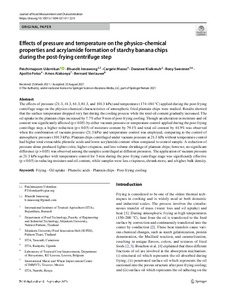Welcome to the International Institute of Tropical Agriculture Research Repository
What would you like to view today?
Effects of pressure and temperature on the physico‑chemical properties and acrylamide formation of starchy banana chips during the post‑frying centrifuge step

View/
Date
2021Author
Udomkun, P.
Innawong, B.
Masso, C.
Klaikreuh, D.
Swennen, R.
Fotso Kuate, A.
Alakonya, A.
Vanlauwe, B.
Type
Review Status
Peer ReviewTarget Audience
Scientists
Metadata
Show full item recordAbstract/Description
The effects of pressure (21.3, 41.3, 61.3, 81.3, and 101.3 kPa) and temperature (174–184 °C) applied during the post-frying centrifuge stage on the physico-chemical characteristics of atmospheric fried plantain chips were studied. Results showed that the surface temperature dropped very fast during the cooling process while the total oil content gradually increased. The oil uptake in the plantain chips increased by 7.7% after 9 min of post-frying cooling. Though an alteration in moisture and oil content was significantly affected (p < 0.05) by either vacuum pressure or temperature control applied during the post-frying centrifuge step, a higher reduction (p < 0.05) of moisture content by 79.1% and total oil content by 44.9% was observed when the combination of vacuum pressure (21.3 kPa) and temperature control was employed, comparing to the control of atmospheric pressure (101.3 kPa). Plantain chips centrifuged under vacuum pressure at 21.3 kPa without temperature control had higher total extractable phenolic acids and lower acrylamide content when compared to control sample. A reduction of pressure alone produced lighter color, higher crispness, and less volume shrinkage of plantain chips; however, no significant difference (p > 0.05) was observed among the samples centrifuged at different pressures. The application of vacuum pressure at 21.3 kPa together with temperature control for 5 min during the post-frying centrifuge stage was significantly effective (p < 0.05) in reducing moisture and oil content, while samples were less crispiness, shrunk more, and a higher bulk density.
https://dx.doi.org/10.1007/s11694-021-01132-0
Multi standard citation
Permanent link to this item
https://hdl.handle.net/20.500.12478/7254IITA Authors ORCID
Patchimaporn Udomkunhttps://orcid.org/0000-0003-0115-1997
Cargele Massohttps://orcid.org/0000-0002-3980-6832
Rony Swennenhttps://orcid.org/0000-0002-5258-9043
Fotso Kuate, A.https://orcid.org/0000-0002-5247-7519
bernard vanlauwehttps://orcid.org/0000-0001-6016-6027
Digital Object Identifier (DOI)
https://dx.doi.org/10.1007/s11694-021-01132-0
